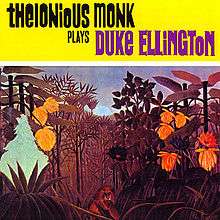Thelonious Monk Plays Duke Ellington
| Thelonious Monk Plays Duke Ellington | ||||
|---|---|---|---|---|
 | ||||
| Studio album by Thelonious Monk | ||||
| Released | 1955 | |||
| Recorded | July 21 and 27, 1955 at Rudy Van Gelder Studio, Hackensack, NJ | |||
| Genre | Bebop[1] | |||
| Length | 36:51 | |||
| Label | Riverside | |||
| Producer | Orrin Keepnews | |||
| Thelonious Monk chronology | ||||
| ||||
| Alternate cover | ||||
 Reissue cover used for pressings from 1958 onward.[3] |
||||
| Professional ratings | |
|---|---|
| Review scores | |
| Source | Rating |
| The Rolling Stone Jazz Record Guide | |
Thelonious Monk Plays Duke Ellington is a 1955 album by Thelonious Monk, comprising his recordings of well-known songs by Duke Ellington. It was Monk's first album to be released by Riverside Records and was recorded by Rudy Van Gelder in Hackensack, NJ. The album was reissued by Riverside on March 27, 2007, in the United States and on April 16, 2007, in the United Kingdom.[5]
Background
The concept of the album was the result of a compromise between Monk and his new label. Although Monk occasionally performed covers, he primarily played his own compositions and he had recorded several albums of originals during 1953-54 for his previous label Prestige Records. However, there was a perception (particularly among music critics) that Monk's own music was "too difficult" for the mainstream record-buying public, and his Prestige albums sold poorly.
After buying out Monk's contract for just over $100, Riverside convinced Monk to record an entire album of Ellington tunes. Monk Plays Ellington was followed by another album of standards by other composers, The Unique Thelonious Monk. Both albums were well received by critics, although they sold only moderately, and ironically it was his third Riverside LP Brilliant Corners, almost completely original material, which became both a commercial and critical success.
The choice of Ellington as the 'theme' composer was evidently made by producer Orrin Keepnews and the Riverside label, but it was nevertheless significant.
At the time the album was recorded, Ellington's profile was yet to revive, and the small-group genres of bebop and cool jazz were in the ascendant. Indeed, at the time the Monk album was released, Ellington had been dropped by his label, Capitol Records and he was struggling to keep his Orchestra together (although he would return to prominence the following year with the Orchestra's legendary performance at the 1956 Newport Jazz Festival).
Reception
Sean Murphy of PopMatters called it "an outstanding album" upon its reissue in 2007 and wrote that it "tends to exist as an overlooked gem in the Monk discography, sandwiched as it is between his earlier “genius of modern music” stage and the mid ‘50s through mid ‘60s, when he made his most enduring work."[5] Allmusic's Lindsay Planer gave the album four out of five stars and felt that Ellington's characteristic "delicacy and inherently intricate melodies" are ideal for "Monk's angular and progressive interpretations." He recommended it to "all dimension of jazz enthusiast", even though "Monk and Ellington aficionados may rate it slightly higher."[6] By contrast, David Rickert of All About Jazz found the album "fairly tame" and lagging with "an ambling pace". Although he viewed it as "a worthy addition to any serious Monk collection", Rickert criticized that it lacked Monk's more "abrasive" sound and "obscures what makes Monk so captivating in the first place."[7]
Jazz pianist Marcus Roberts called the album "a masterpiece in jazz" and cited it as a template for his 1990 album Alone with Three Giants: "When you think of great artists paying homage to great artists, that one recording let me know what I had to do."[8]
Track listing
| Track | Song Title | Time |
|---|---|---|
| 1. | "It Don't Mean a Thing (If It Ain't Got That Swing)" | 4:38 |
| 2. | "Sophisticated Lady" | 4:27 |
| 3. | "I Got It Bad and That Ain't Good" | 5:52 |
| 4. | "Black and Tan Fantasy" | 3:24 |
| 5. | "Mood Indigo" | 3:13 |
| 6. | "I Let a Song Go Out of My Heart" | 5:40 |
| 7. | "Solitude" | 3:42 |
| 8. | "Caravan" | 5:55 |
Personnel
References
- ↑ Bailey, C. Michael (March 20, 2004). "Thelonious Monk: Thelonious Monk Plays Duke Ellington". All About Jazz. Retrieved February 21, 2013.
- ↑ Kelley, Robin D.G. (2009). Thelonious Monk: The Life and Times of an American Original. New York: Free Press. p. 249.
- ↑ Kelley, Robin D.G. (2009). Thelonious Monk: The Life and Times of an American Original. New York: Free Press. p. 249.
- ↑ Swenson, J. (Editor) (1985). The Rolling Stone Jazz Record Guide. USA: Random House/Rolling Stone. p. 145. ISBN 0-394-72643-X.
- 1 2 Murphy, Sean (October 5, 2007). "Thelonious Monk: Thelonious Monk Plays Duke Ellington". PopMatters. Retrieved February 21, 2013.
- ↑ Planer, Lindsay. "Plays Duke Ellington - Thelonious Monk". Allmusic. Rovi Corporation. Retrieved February 20, 2013.
- ↑ Rickert, David (April 2, 2004). "Thelonious Monk: Thelonious Monk Plays Duke Ellington". All About Jazz. Retrieved February 21, 2013.
- ↑ Franckling, Ken (1991). "Alone With Three Giants: A matter of homage, respect and growth". JazzTimes. 21 (2): 15.